Influence of Crossing Cable Arrangement on the Static Performance of Long-Span Three-Tower Cable-Stayed Bridges
Abstract
1. Introduction
2. Analysis of Sag Effect Influence
3. Finite Element Analysis
3.1. Structural Parameters of the Three-Tower Cable-Stayed Bridge
3.2. Finite Element Model
3.3. Structural Response of Three-Tower Cable-Stayed Bridge Under Live Load
4. Analysis of Influencing Factors of Crossing Cable
- (1)
- A pair of crossing cables are added to the three-tower cable-stayed bridge, and then the anchorage position of the crossing cable on the main beam is changed to verify the optimal anchorage position.
- (2)
- By changing the ratio of the crossing cable area between the mid tower and the side tower, the influence of the crossing cable area ratio on the constraint stiffness is analyzed.
- (3)
- By changing the number of crossing cables, the improvement effect of setting crossing cables on the structural performance of long-span three-tower cable-stayed bridge is analyzed.
- (4)
- The height of the tower below the deck is changed, and the effect of setting crossing cables for cable-stayed bridges with different tower heights is analyzed.
4.1. Anchor Span Ratio of Crossing Cable
4.2. Ratio of Crossing Cable Area Between Mid Tower and Side Tower
4.3. Number of Crossing Cables
4.4. Tower Height
5. Conclusions
- (1)
- The analytical formula of the longitudinal constraint stiffness of crossing cables based on the equivalent elastic modulus has high accuracy and can be used to determine the anchorage position with the maximum constraint stiffness of the crossing cables in long-span three-tower cable-stayed bridges.
- (2)
- As the main span length increases, the sag effect becomes significant, causing the anchorage position with the maximum constraint stiffness of the crossing cables to shift toward the mid span. Taking a three-tower cable-stayed bridge with a height-to-span ratio of 0.25 as an example, when the cable stress level reaches 600 MPa, expanding the span from 700 m to 1500 m reduces the anchorage span ratio of the crossing cables from 0.69 to 0.63. Increasing the initial stress of the crossing cables helps improve their constraint stiffness, while the anchorage position with maximum constraint stiffness moves closer to the side towers.
- (3)
- When the steel volume of the crossing cable is constant, increasing the ratio of the crossing cable area between the mid tower and the side tower can make full use of the restraining effect of the ordinary cables near the crossing cable of the side tower on the deck, so as to improve the restraining effect of the crossing cable on the mid tower.
- (4)
- For multi-tower cable-stayed bridges with main spans exceeding 1000 m, the installation of crossing cables can still effectively enhance structural stiffness and reduce bending moments of the tower bottom. In the case study of this paper, after adding six pairs of crossing cables to three-tower cable-stayed bridges with main spans of 1000 m and 1500 m, the vertical displacement of the deck decreased by 55% and 40%, respectively, while the bending moment at the base of the mid tower was reduced by 44% and 46%.
- (5)
- When the tower height below the deck is increased, the crossing cables can still effectively improve the deformation of the deck and the bending moment of the mid tower. Therefore, for a three-tower cable-stayed bridge built in the deep-water area, the setting of crossing cables in the main span is still an effective measure to improve the structural stiffness.
Author Contributions
Funding
Institutional Review Board Statement
Informed Consent Statement
Data Availability Statement
Conflicts of Interest
References
- Gimsing, N.J.; Georgakis, C.T. Cable Supported Bridges Concept and Design, 3rd ed.; Wiley: New York, NY, USA, 2011. [Google Scholar]
- Janjic, D. Structural Analysis of the Sutong Bridge; Bentley Systems Incorporated: Ningbo, China, 2007. [Google Scholar]
- Pipinato, A. Case study: The Russky bridge. In Innovative Bridge Design Handbook; Butterworth-Heinemann: Oxford, UK, 2016; pp. 671–680. [Google Scholar]
- Qin, S.Q.; Xu, W.; Lu, Q.F.; Zheng, Q.G.; Fu, Z.G.; Wan, R.A.A.; Sun, J.L. Overall Design and Concept Development for Main Navigational Channel Bridge of Changtai Changjiang River Bridge. Bridge Constr. 2020, 50, 1–10. (In Chinese) [Google Scholar]
- Liu, Q.Y.; He, M.; Li, X.L.; Zhang, Q. Research on Design and Construction of Main pylon of Maanshan Changjiang River Highway Bridge. Appl. Mech. Mater. 2014, 587, 1604–1607. [Google Scholar] [CrossRef]
- Arnaud, S.; Matsunaga, N.; Nagano, S.; Ragaru, J. Behavior of a multiple spans cable-stayed bridge. In Tailor Made Concrete Structures: New Solutions for our Society; Taylor & Francis Group: Abingdon, UK, 2008; pp. 807–813. [Google Scholar]
- Arellano, H.; Gomez, R.; Tolentino, D. Parametric analysis of multi-span cable-stayed bridges under alternate loads. Balt. J. Road Bridge Eng. 2019, 14, 543–567. [Google Scholar] [CrossRef]
- Virlogeux, M. Bridges with multiple cable-stayed spans. Struct. Eng. Int. 2001, 11, 61–82. [Google Scholar] [CrossRef]
- Gimsing, N.J. Multispan stayed girder bridges. J. Struct. Div. 1976, 102, 1989–2003. [Google Scholar] [CrossRef]
- Combault, J.; Teyssandier, J.P. Rion-Antirion bridge, greece-concept, design and construction. Struct. Eng. Int. 2005, 15, 22–26. [Google Scholar] [CrossRef]
- Buonomo, M.; Servant, C.; Virlogeux, M.; Cremer, J.M.; de Ville De Goyet, V.; Forno, J.D. The design and the construction of the Millau Viaduct. Steelbridge 2004, 2004, 165–182. [Google Scholar]
- Bergermann, R.; Schlaich, M. Ting Kau Bridge, Hong Kong. Struct. Eng. Int. 1996, 6, 152–154. [Google Scholar] [CrossRef]
- Hussain, N.; Hornby, R.; Minto, B.; Carter, M.; Kite, S. Queensferry Crossing, UK: Scheme, specimen and definition design. Proc. Inst. Civ. Eng.-Bridge Eng. 2019, 172, 92–112. [Google Scholar] [CrossRef]
- Pan, F. Overall Design and Innovation of Huangmaohai Link Project. Bridge Constr. 2021, 51, 10–16. (In Chinese) [Google Scholar]
- Chai, S.B.; Xiao, R.C.; Wang, X.L. Longitudinal restraint stiffness of crossed cables in multi-tower cable-stayed bridge. J. Harbin Inst. Technol. 2016, 9, 119–124. (In Chinese) [Google Scholar]
- Chai, S.B.; Wang, X.L. Simplified calculation method for deformation of multi-tower cable-stayed bridges with crossed cables. Eng. Struct. 2019, 181, 354–361. [Google Scholar] [CrossRef]
- Chai, S.B.; Zhang, R.L.; Wang, X.L.; Huang, K.J. Asymmetric arrangement of crossed cables in multitower cable-stayed bridges based on structural stiffness. J. Bridge Eng. 2023, 28, 04022142. [Google Scholar] [CrossRef]
- Yao, S.S.; Peng, B.; Wang, L.Y.; Chen, H.D. Analytical Solution for Longitudinal Anti-Push Stiffness of the Middle Tower of Cross-Cable Multi-Tower Cable-Stayed Bridge. Buildings 2023, 13, 2158. [Google Scholar] [CrossRef]
- Shao, X.D.; Deng, F.H.; Deng, L. Conceptual design of a new three-tower cable-stayed bridge system with unequal-size fans. J. Bridge Eng. 2018, 23, 06018002. [Google Scholar] [CrossRef]
- Baldomir, A.; Tembrás, E.; Hernández, S. Optimization of cable weight in multi-span cable-stayed bridges. Application to the Forth Replacement Crossing. In Multi-Span Large Bridges; CRC Press: Porto, Portugal, 2015; p. 620. [Google Scholar]
- Arellano, H.; Tolentino, D.; Gómez, R. Optimum criss crossing cables in multi-span cable-stayed bridges using genetic algorithms. KSCE J. Civ. Eng. 2019, 23, 719–728. [Google Scholar] [CrossRef]
- Cid, C.; Baldomir, A.; Hernández, S. Optimum crossing cable system in multi-span cable-stayed bridges. Eng. Struct. 2018, 160, 342–355. [Google Scholar] [CrossRef]
- Huang, K.J.; Chai, S.B.; Wang, X.L. Crossing cable design optimization of multi-tower cable-stayed bridge based on joint analytical method and genetic algorithm. Structures 2024, 69, 107335. [Google Scholar] [CrossRef]
- Asgari, B.; Osman, S.A.; Adnan, A. Three-dimensional finite element modelling of longspan cable-stayed bridges. IES J. Part A Civ. Struct. Eng. 2013, 6, 258–269. [Google Scholar] [CrossRef]
- Nazmy, A.S.; Abdel-Ghaffar, A.M. Three-dimensional nonlinear static analysis of cable-stayed bridges. Ind. Constr. 1990, 34, 257–271. [Google Scholar] [CrossRef]
- Ren, W.X. Ultimate behavior of long-span cable-stayed bridges. J. Bridge Eng. 1999, 4, 30–37. [Google Scholar] [CrossRef]
- Der, E.J. E-Modul von Seilen unter berucksichtigung des Durchhanges. Bauingenieur 1965, 40, 52–55. (In German) [Google Scholar]
- Wang, P.H.; Yang, C.G. Parametric studies on cable-stayed bridges. Comput Struct. 1996, 60, 243–260. [Google Scholar] [CrossRef]
- Xi, Y.; Kuang, J.S. Ultimate load capacity of cable-stayed bridges. J. Bridge Eng. 1999, 4, 14–22. [Google Scholar] [CrossRef]
- Song, C.L.; Xiao, R.C.; Sun, B. Optimization of cable pre-tension forces in long-span cable-stayed bridges considering the counterweight. Eng. Struct. 2018, 172, 919–928. [Google Scholar] [CrossRef]
- ANSYS User Documentation; ANSYS Inc.: Pittsburgh, PA, USA, 2021.
- Lai, Y.; Wu, Y.; Wang, G. Novel long-span cable-stayed deck arch bridge: Concept and structural characteristics. Eng. Struct. 2024, 308, 118026. [Google Scholar] [CrossRef]
- Zhang, W.M.; Zou, H.X.; Chen, J.; Chang, J.Q. An analytical method for adjusting dead load allocation between side and central cables in a cable-stayed bridge with three cable planes. Structures 2023, 48, 1761–1771. [Google Scholar] [CrossRef]
- Daniell, W.E.; Macdonald, J.H. Improved finite element modelling of a cable-stayed bridge through systematic manual tuning. Eng. Struct. 2007, 29, 358–371. [Google Scholar] [CrossRef]



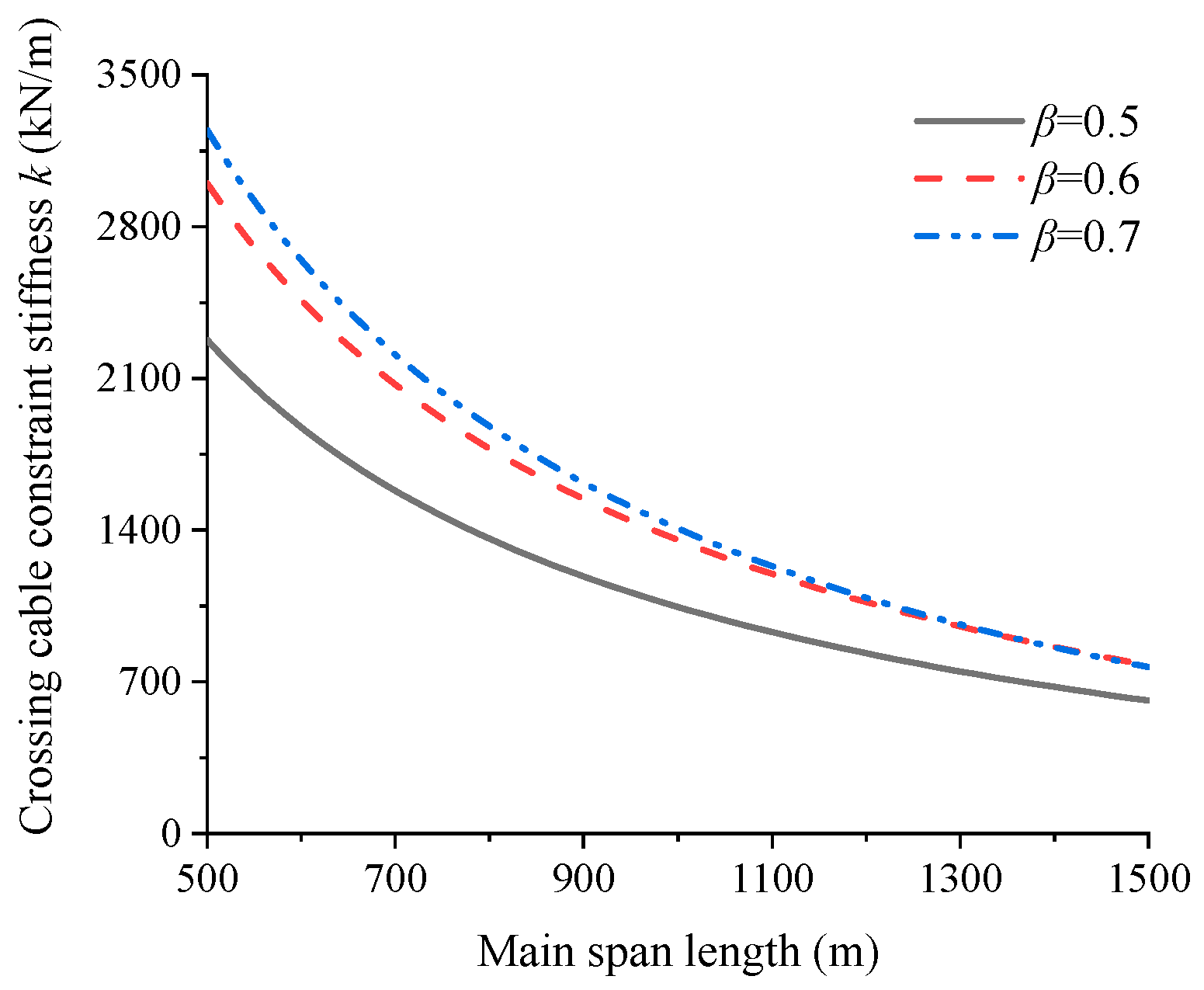
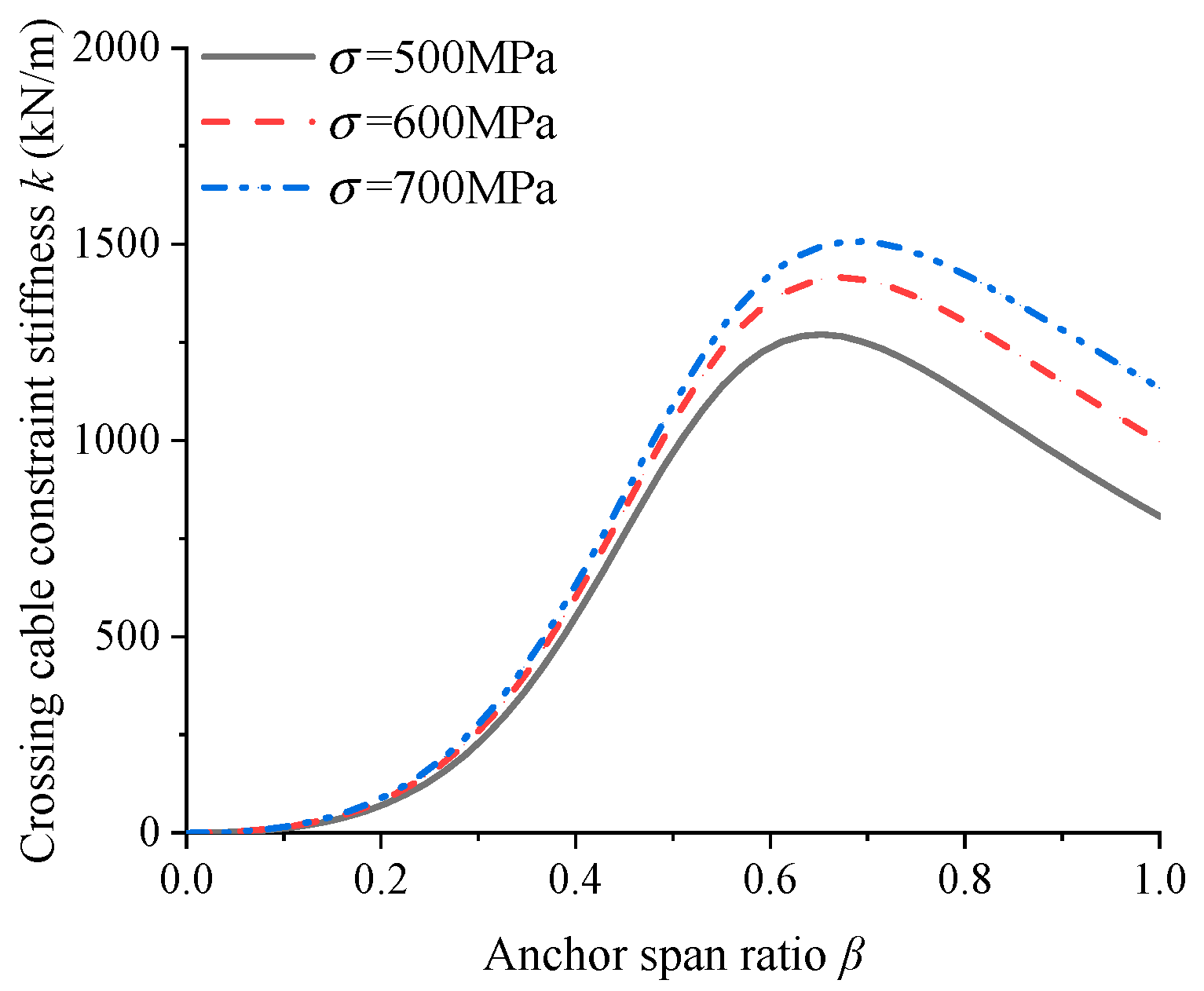
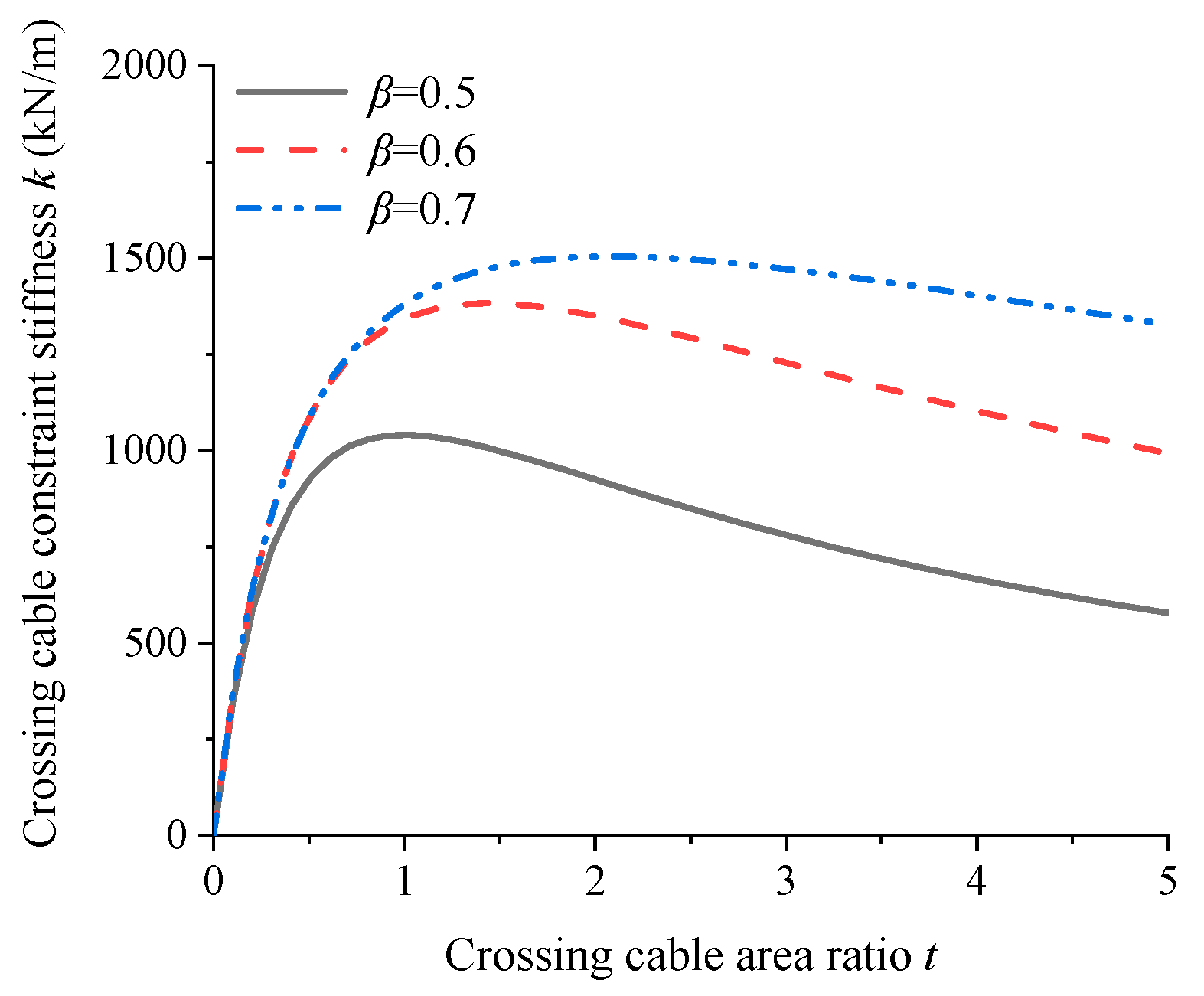
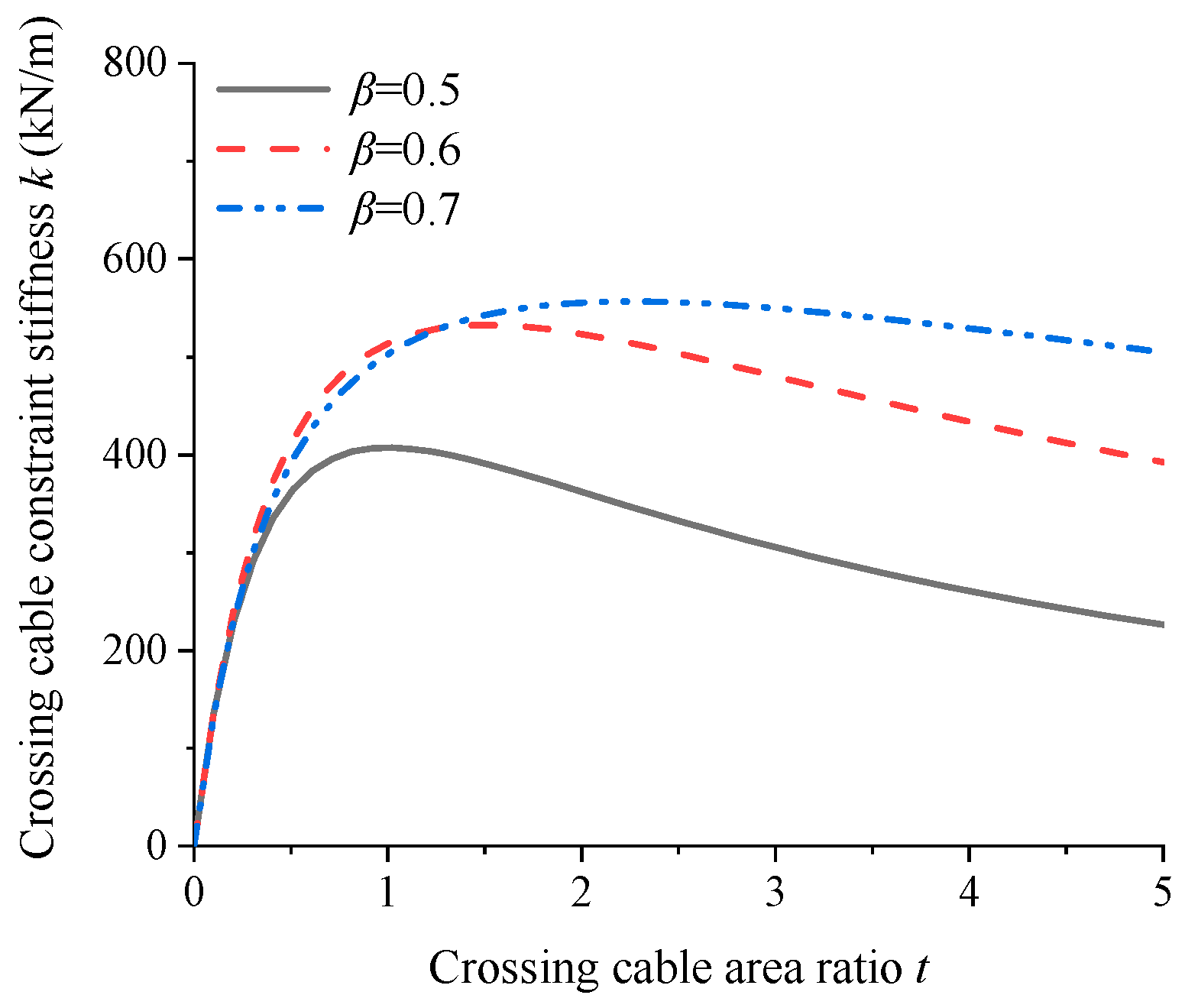

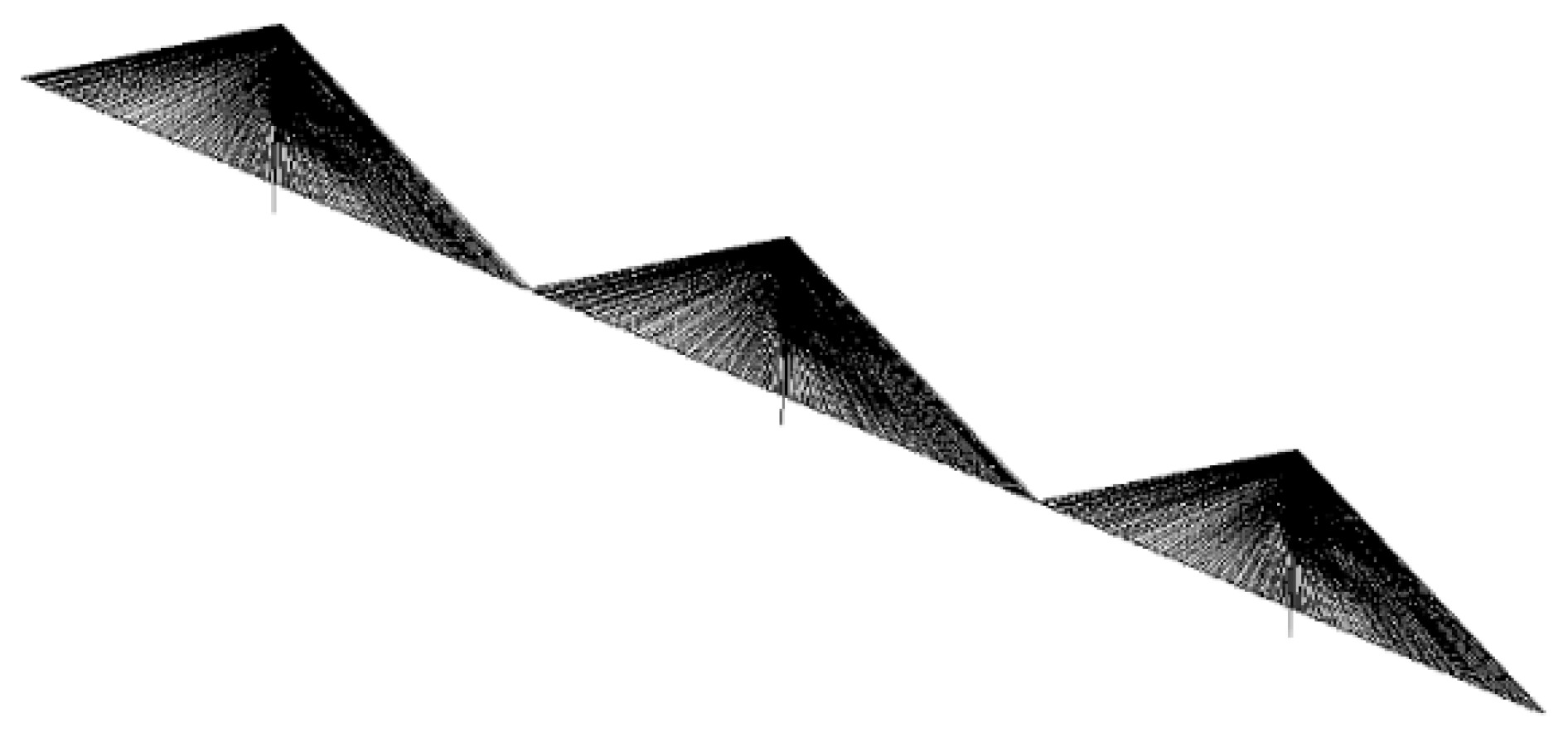
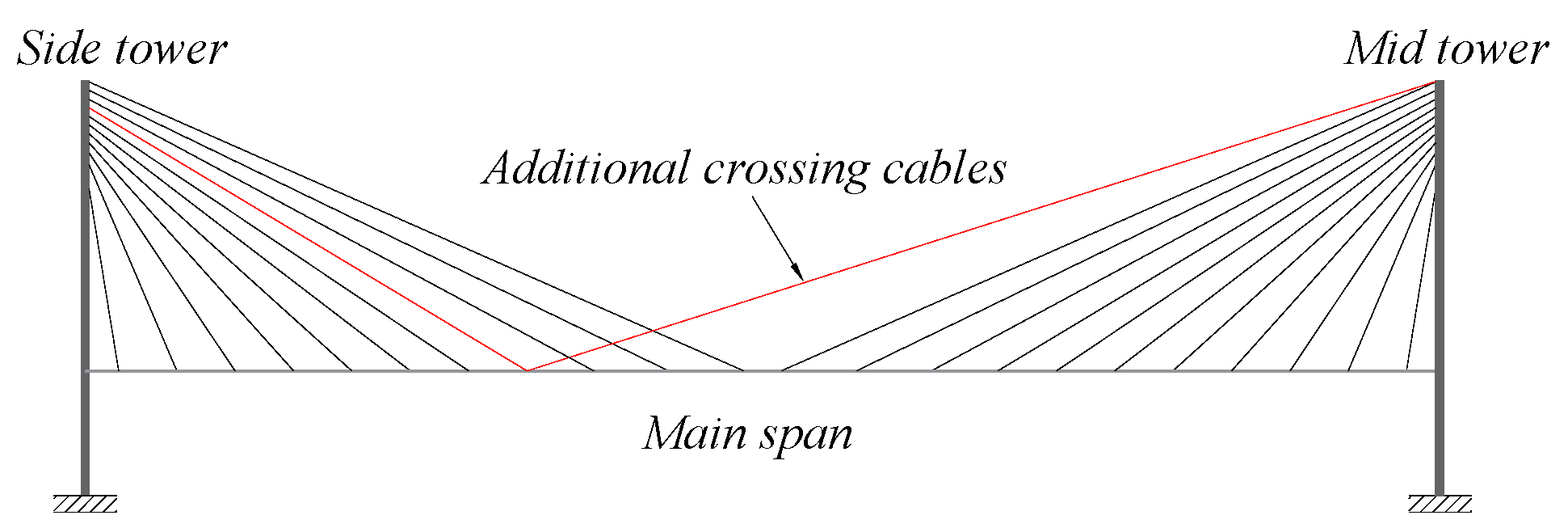

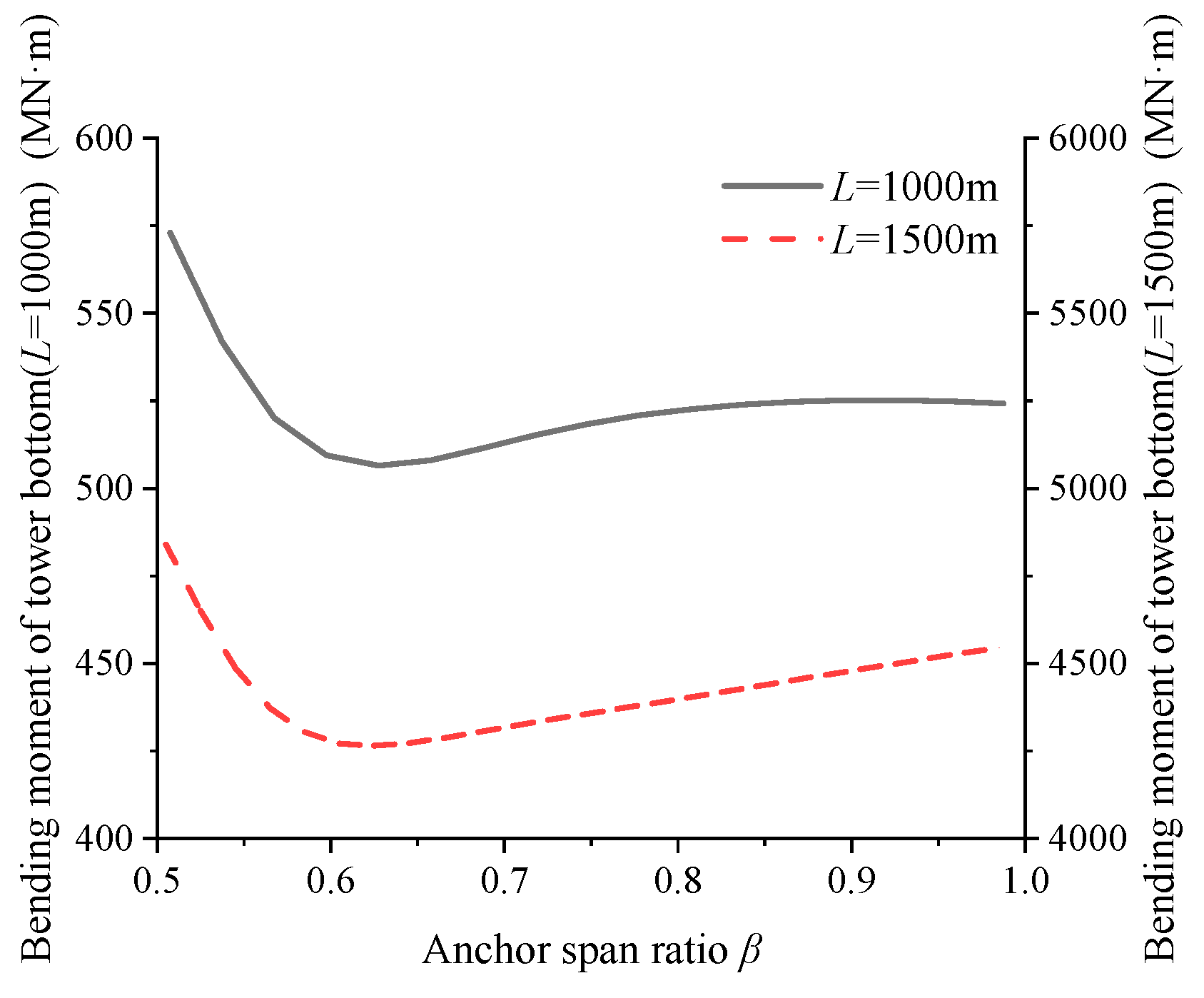
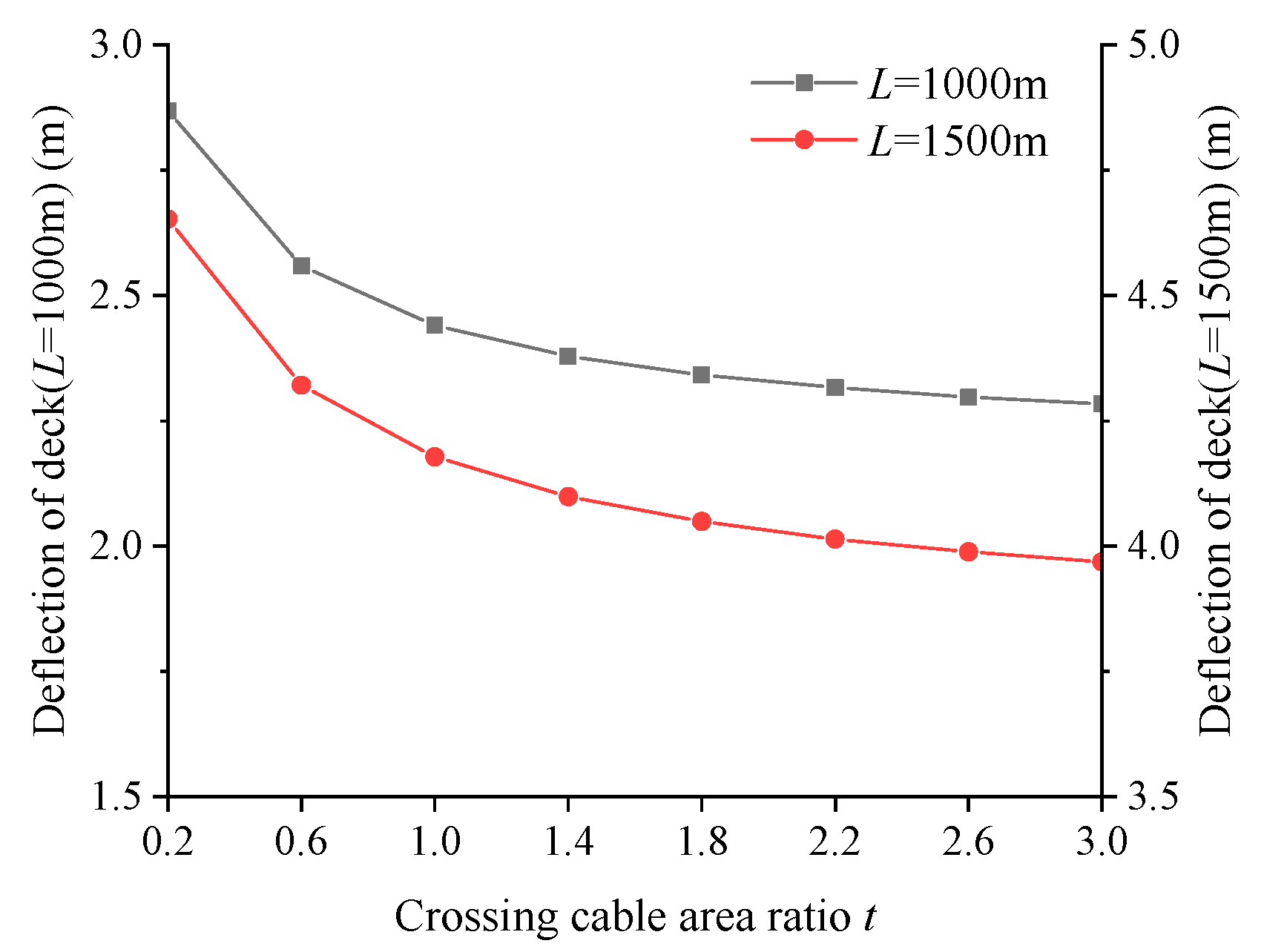
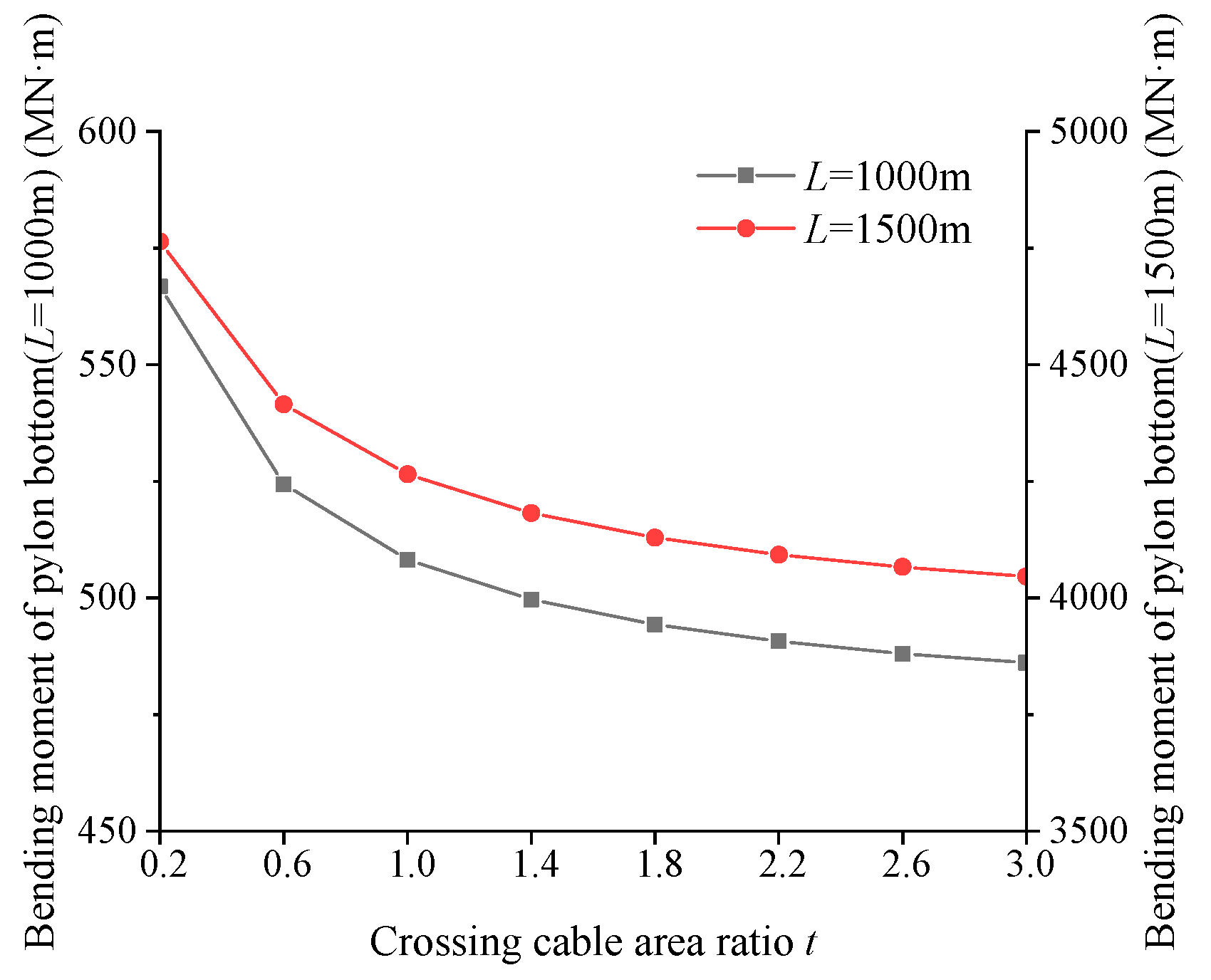
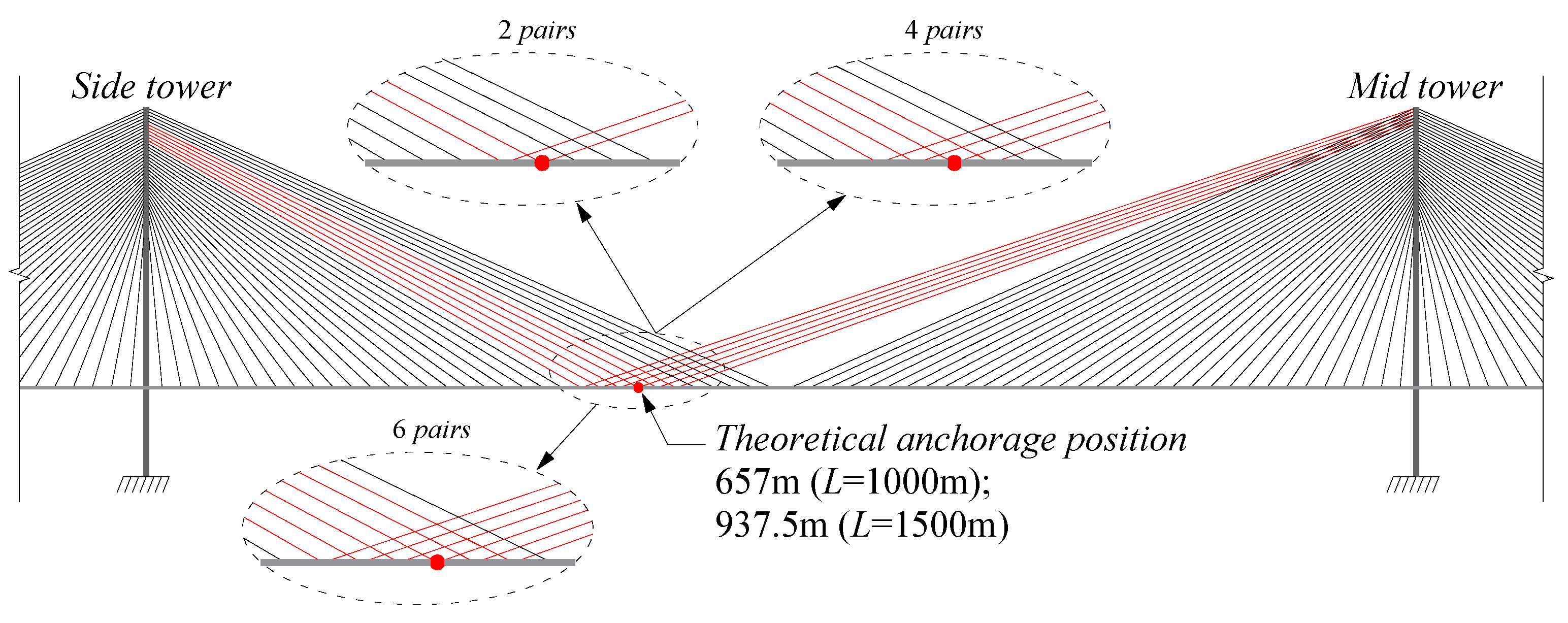


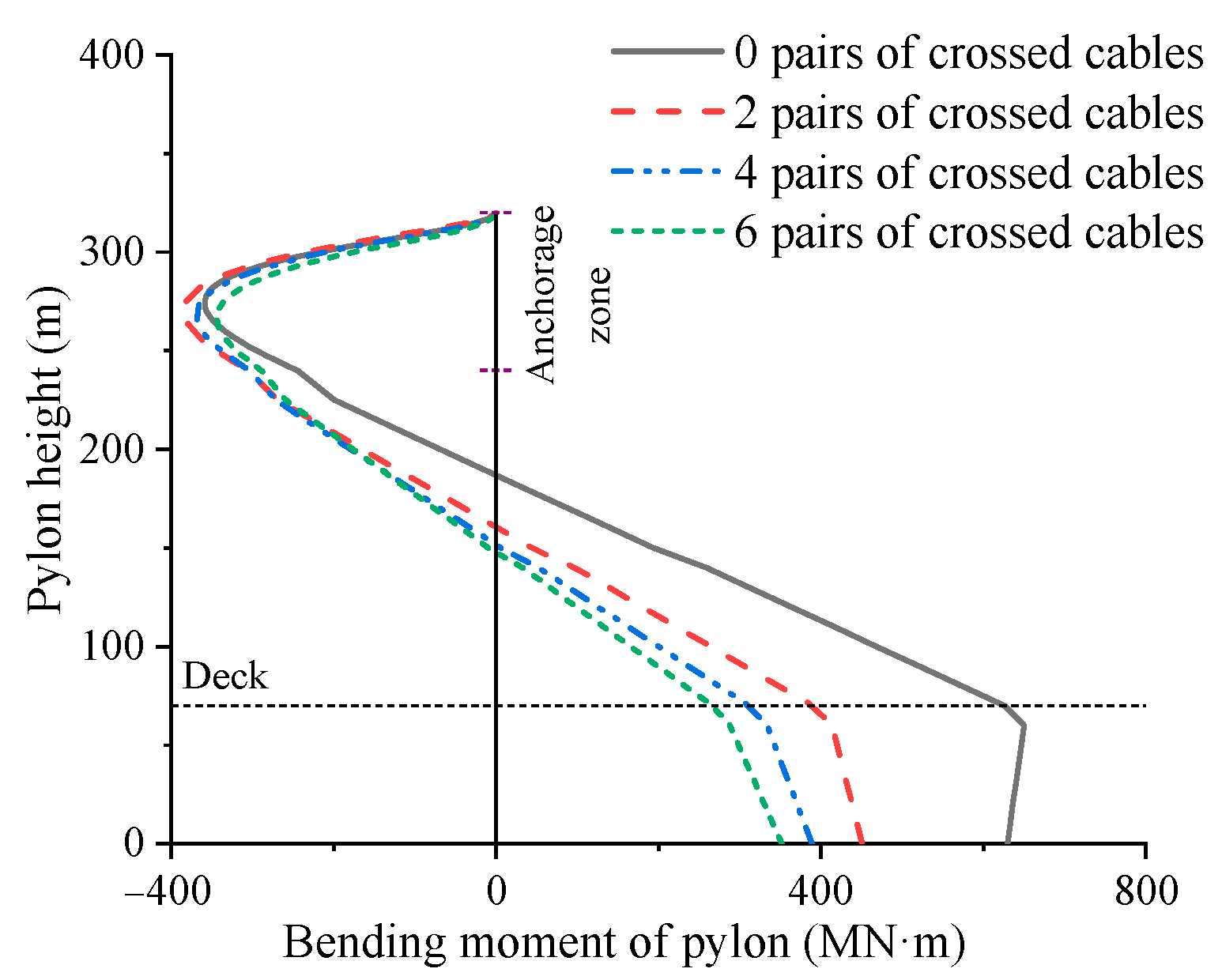
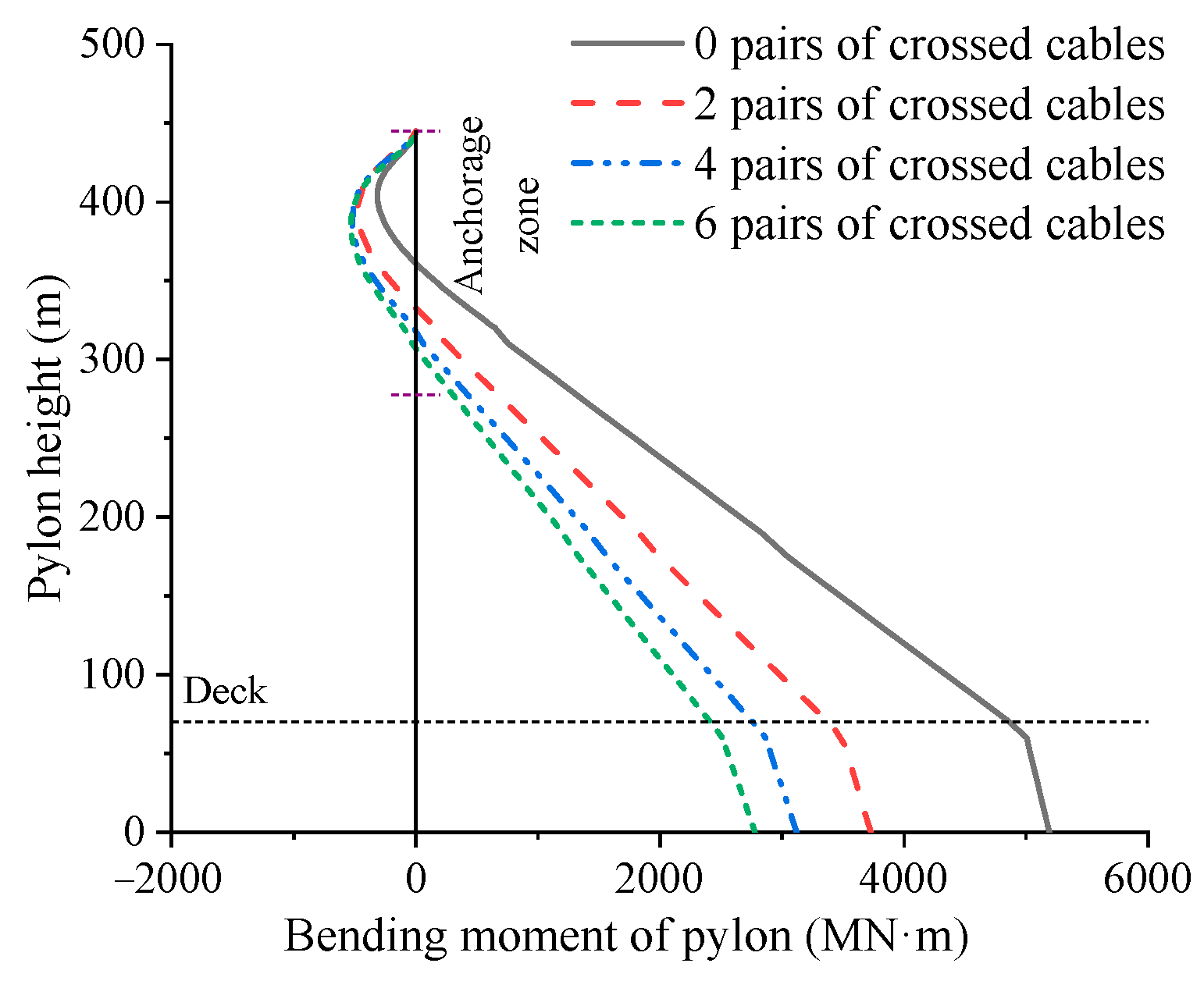
| Component | Material | Area (m2) | Inertia Moment (m4) | Elastic Modulus (GPa) |
|---|---|---|---|---|
| Deck | Q345 | 2.16 | 3 | 205 |
| Tower | Concrete C60 | 46.4/112 | 291/3733 | 35 |
| Cable | Parallel steel wire | 0.005/0.007/0.008 | / | 205 |
| Structural Response | L = 1000 m | L = 1500 m |
|---|---|---|
| Maximum deflection of deck (m) | 3.33 | 5.05 |
| Maximum stress of the deck (MPa) | 94.50 | 147.81 |
| Bending moment of mid-tower bottom (MN·m) | 640.31 | 5190.05 |
| Stress of mid-tower bottom (MPa) | 22.61 | 25.94 |
| Maximum stress of cable (MPa) | 806 | 794 |
| Main Span | Tower Height Below Deck | 0 Pairs of Crossing Cables | 6 Pairs of Crossing Cables | Deflection Reduction |
|---|---|---|---|---|
| L = 1000 m | 70 | 3.33 | 1.48 | 55.55% |
| 120 | 3.40 | 1.50 | 56.11% | |
| 170 | 3.44 | 1.50 | 56.37% | |
| L = 1500 m | 70 | 5.05 | 2.83 | 43.96% |
| 120 | 5.47 | 2.93 | 46.52% | |
| 170 | 5.77 | 2.99 | 48.17% |
| Main Span | Tower Height Below Deck | 0 Pairs of Crossing Cables | 6 Pairs of Crossing Cables | Bending Ree |
|---|---|---|---|---|
| L = 1000 m | 70 | 629.46 | 351.49 | 44.16% |
| 120 | 436.87 | 275.83 | 36.86% | |
| 170 | 304.71 | 220.75 | 27.55% | |
| L = 1500 m | 70 | 5190.73 | 2778.71 | 46.47% |
| 120 | 4443.35 | 2347.47 | 47.17% | |
| 170 | 3816.81 | 1992.38 | 47.80% |
Disclaimer/Publisher’s Note: The statements, opinions and data contained in all publications are solely those of the individual author(s) and contributor(s) and not of MDPI and/or the editor(s). MDPI and/or the editor(s) disclaim responsibility for any injury to people or property resulting from any ideas, methods, instructions or products referred to in the content. |
© 2025 by the authors. Licensee MDPI, Basel, Switzerland. This article is an open access article distributed under the terms and conditions of the Creative Commons Attribution (CC BY) license (https://creativecommons.org/licenses/by/4.0/).
Share and Cite
Chai, S.; Huang, K.; Wang, X. Influence of Crossing Cable Arrangement on the Static Performance of Long-Span Three-Tower Cable-Stayed Bridges. Appl. Sci. 2025, 15, 6355. https://doi.org/10.3390/app15116355
Chai S, Huang K, Wang X. Influence of Crossing Cable Arrangement on the Static Performance of Long-Span Three-Tower Cable-Stayed Bridges. Applied Sciences. 2025; 15(11):6355. https://doi.org/10.3390/app15116355
Chicago/Turabian StyleChai, Shengbo, Kaijie Huang, and Xiulan Wang. 2025. "Influence of Crossing Cable Arrangement on the Static Performance of Long-Span Three-Tower Cable-Stayed Bridges" Applied Sciences 15, no. 11: 6355. https://doi.org/10.3390/app15116355
APA StyleChai, S., Huang, K., & Wang, X. (2025). Influence of Crossing Cable Arrangement on the Static Performance of Long-Span Three-Tower Cable-Stayed Bridges. Applied Sciences, 15(11), 6355. https://doi.org/10.3390/app15116355





